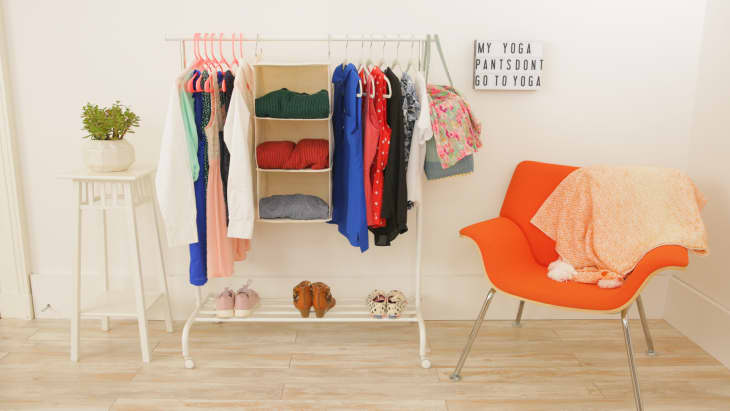7 Simple Closet Tricks That Let You Do Less Laundry (and Keep Your Bedroom Clean)

Not all laundry is created equal. Those leggings you wore to a super-sweaty hot yoga sesh? Toss those in the washer post haste. But things like a sweater you threw on for the late half of a chilly night? A dry-clean only blouse you wore to work on a half-day summer Friday? Literally any pair of jeans that’s not ripping at the seams (and even then…)? You can totally wear that again before you wash.
A lot of people—officially and unofficially—designate a spot in the bedroom as their “clothing purgatory”: A place to put worn-but-not-yet-ready-for-a-wash clothes. It’s a good method (in fact, we recommend a bunch of clothing purgatory organizing solutions in this post), but it’s not perfect. If you’re not careful, your efficient purgatory chair can become an ugly pile-up, making your bedroom look messier than it is.
Instead, consider taking on a new laundry-sorting system using one of these closet hacks. The idea is that you should be able to put away all your wear-again clothes back into the closet or dresser while still making sure you know which ones are ready for the next trip to the laundromat or dry-cleaners.
Not interested in something DIY? These “Hanger Brains” (around $1 a piece from Amazon) are designed to track wears for each garment in your closet.
The Button System
Button only the top button on shirts that are totally clean, button a middle button on shirts that have been worn already but could be worn again.
The Bread Tag System
Save those plastic bread tags and reuse them as clothes markers. Keep a bowl of them in your closet, and attach a tag to the hanger, tag or belt loop of clothes that have been worn before putting them away.
The Safety Pin System
A lot like the bread tag system, but using a safety pin instead. You probably have a graveyard of them somewhere, but if you need to buy new, you can buy literally a GROSS amount of safety pins (aka 1,440 — or 10 grosses) for $8. The safety pin system is great for leggings (fasten a safety pin through the waistband), sweaters (link a safety pin around the tag at the back of the collar) and jeans (attach a safety pin around the belt loop)—and you can maybe even leave it there even while you wear them.
The Divider Method
Separate your closet rod into “clean” and “worn but still wearable” sections with a divider. If you already have a natural division in your closet—like a hanging shoe organizer—you can start stashing your worn-but-wearable clothes on the other side of the organizer from where you normally hang your clothes. Or add a divider—like an empty garment bag, a single brightly-colored hanger or these retail-style tags from Amazon.
The Colored Hanger Method
Keep a small supply of different-color hangers on hand and use them when you hang your already-worn clothes back up.
The Paper Tag System
For something like a dry-clean-only item where you’re trying to really maximize wears, you’ll want a system that shows you how much a thing’s been worn. Use Recovering Shopaholic‘s paper tag system: Hang a fresh paper tag on the hanger (or around the belt loop or tag using a girth hitch) when the garment is washed clean, and mark it each time the thing is worn.
The Reverse Hanger System
When clothes are clean, hang them in the closet with the hanger forwards (with the hook opening towards the back of the closet). When clothes are worn, but not ready for the hamper, hang them back up with the hanger backwards (with the hook opening towards you). The next time you do a load of laundry, grab the clothes on “backwards” hangers for a wash.